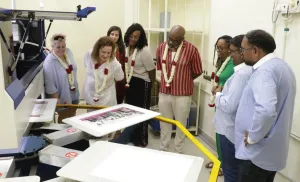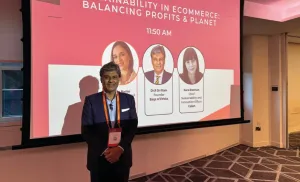5 Plastic-free Solutions for a Promising Future of Packaging
Plastic packaging is absolutely everywhere. Whether we want to or not, most of us come into contact with some form of plastic packaging or another multiple time a day. Small, big, fine, thick, plastic in plastic, plastic on plastic, single-use, reusable…it is hard to escape.
Something that is also hard to escape, is the material’s recent bad publicity and subsequent war on plastic. I’m sure by now most of us have seen the heartbreaking footage of the dead whale’s stomach full of plastic bags, or David Attenborough combing the shoreline with armfuls of decade old plastic pollution. I am also sure that most of us have felt frustrated when we place an online order and it arrives like a Russian doll inside layers and layers of plastic packaging.
This idea of single-use plastic packaging is nothing new – plastic has been the preferred form of packaging for many people and companies alike since its market debut in the 1950’s. Polyethylene (the most common form of single use plastic) is strong, waterproof and cheap to produce – the trouble is, it can last forever (unlike the non-renewable petrochemicals that it’s made from).
In 1954 – at around same time that plastic packaging was gaining popularity – Albert Einstein said “we shall require a substantially new manner of thinking if humanity is to survive”. Just imagine what he would say if he could see what we are doing to the planet now, some 60 years later.
Einstein was absolutely right – we are going to have to make some significant changes if we are to sustain life (human or otherwise) on earth. Here are 5 biodegradable, renewable and plastic-free packaging solutions that could clean up the packaging industry:
1. Paper
Paper is one of the oldest forms of packaging and outdates plastic by centuries. It starts life as a cellulose pulp derived from renewable wood, grasses or textiles, which is then dried into sheets to be used. Most significantly, paper is recyclable and will react with the elements in nature and biodegrade after its use. The classic white paper we all know so well can be criticised for its use of bleach and other chemicals. However, the paper used for packaging is often unbleached and coarser than conventional school-style paper which means that fewer chemicals and refining have been used in its production. Not only that, but as previously stated – paper packaging doesn’t necessarily need to come from wood. In theory, anything that grows can be used to make a pulp – hemp, jute, actual grass can all produce a form of paper, thus avoiding the need to cut down trees or the use of high volumes of water or chemicals.
Obviously paper would not stand up to a plastic bag if being delivered on a rainy day, but it could definitely be used instead of plastic for inside the packages for extra protection.
2. MUSHROOM PLASTIC
Fungi packaging was invented in response to humanity’s plastic problem. Mushrooms were the first colonisers of the planet and predate the earliest of plant species by over 1 billion years! There were even times when vast mushroom forests covered the land. Therefore it is no surprise that fungi is well-rehearsed at thriving with minimal amounts of water and without chemical additives, thus making it a great material for packaging. Fungi is such a versatile material that it can be used as packaging insulation, boxes, “plastic” style packaging and even surfboards! The fine roots of the mushroom are known as mycelium and these are what is used to create the packaging. Mycelium is renewable – it’s grown instead of extracted from non-renewable sources – and is so biodegradable that you can just put it on your compost.
3: Hemp plastic
Hemp is one of the oldest crops cultivated on earth and dates back as early as Neolithic periods. Besides textiles, the plant has myriad applications including biofuel, phytoremediation (removing toxins from soils using plants) and building materials. It also has huge promise in the packaging industry and can be used to produce paper and plastic-like materials. Like all of the materials in this listicle, hemp is natural, renewable and biodegradable but this plant offers some other environmental benefits. It grows incredibly quickly and produces a large yield without the need for chemical pesticides or large volumes of water and because it is so leafy it absorbs a lot of CO2 and releases more oxygen during its growth than other plants. Hemp stalks contain fibres that are so long and strong that they rival even synthetic polymer chains and can be up to 2.5 times stronger than polypropylene – meaning that a plastic made from hemp can last at least as long as a synthetic counterpart but will biodegrade at the end of its life without releasing any harmful chemicals during the process.
4: Starch-based polymers
The term “polymer” is commonly believed to be synonymous with plastic. However this is actually incorrect – a polymer is simply a chemical compound whose molecules are connected together in chains. Whilst it’s true that plastic is a synthetic polymer derived from non-renewable petrochemicals, it’s false to claim that all polymers are derived from oil. In fact, starch-based polymers have a startlingly similar feel to plastic bags with the added benefit of throwing them into your compost bin with your food waste. These starch polymers are cheap to produce, renewable and completely biodegradable, but they do not come without their drawbacks. The molecules made from starch are more hydrophilic (the opposite of water resistant) than synthetic polymer and this can cause them to break down at at accelerated rate. Therefore, although it would be unrealistic to suggest that all plastics were replaced with starch polymers, it could be possible to use them as a renewable and biodegradable alternative to single-use plastic packaging.
5: Bamboo
Bamboo is another one of our planet’s most versatile plants, it has been cultivated for thousands of years and has uses for food, building materials, textiles and paper. Bamboo is a viable solution for the environmental problems caused by packaging because it is renewable, biodegradable and grows very fast without the need for chemical pesticides or fertilisers. Bamboo can also produce a wide range of packaging products due to its strength and flexibility – this means that many different types of packaging can be made from the same plant and this is an economical use of the time and resources required for its cultivation.




